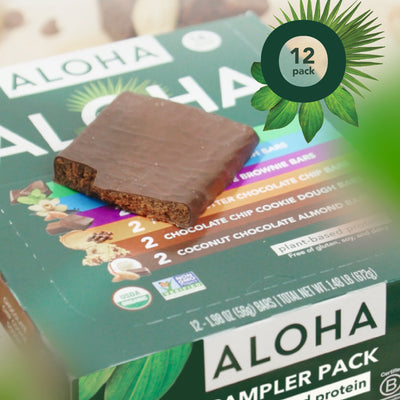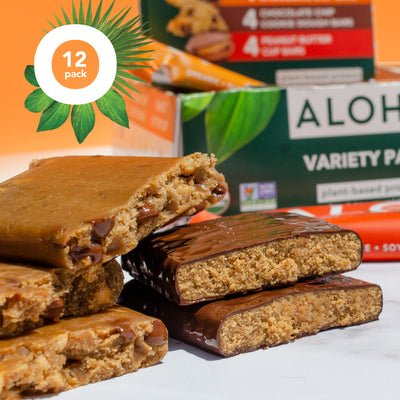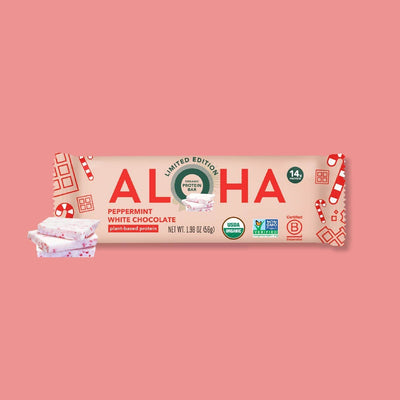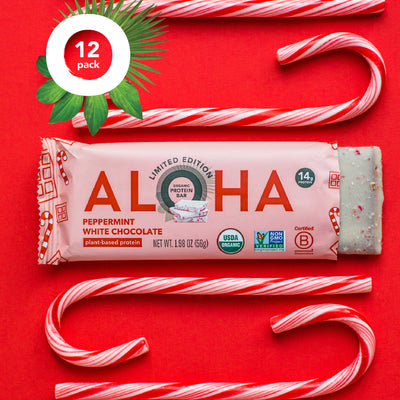Key Takeaways:
- Ingredient Clarity: Readers will learn what protein powders are made of, from the core protein source to common add-ins.Plant-.
- Based Benefits: The article highlights how plant-based ingredients support clean nutrition and sustainability.
- Smart Selection: It offers guidance on how to choose a high-quality powder that fits individual needs and preferences.
Protein powder has become a go-to staple for smoothies, snacks, and even baking. But while it’s easy to scoop and blend, it’s not always clear what’s actually inside the tub. From the type of protein used to all the extra ingredients listed on the label, the makeup of a powder can vary a lot. And if you're trying to make better choices for your health, it helps to know what you're working with.
At ALOHA, we believe better ingredients make a better product. Our plant-based protein powders are made with real food, never with shortcuts or fillers. They’re USDA Organic, Non-GMO Project Verified, Certified Vegan, and soy-free. We’re proud to be an employee-owned, Certified B Corp with a commitment to people, the planet, and plant-based nutrition that tastes good and feels good. Our goal has always been to make healthy eating easier and more enjoyable for everyone.
In this piece, we’ll be talking about what protein powder is made of, what ingredients you can expect to find, and why the quality of those ingredients really matters.
The Basics: What Protein Powder Is Used For
Protein powder is a convenient way to increase your daily protein intake. People use it to support muscle recovery, maintain energy levels, and stay full between meals. It can be part of a workout routine, a busy morning, or simply a way to feel more nourished.
Protein plays an essential role in the body. It helps build and repair muscle, supports the immune system, and keeps everyday functions running smoothly. When meals fall short or schedules get hectic, protein powder makes it easier to meet your needs.
You can blend it into smoothies, stir it into oatmeal, or mix it with your favorite milk or water. There are several types, including whey, collagen, and plant-based options. Each offers a different source, but all aim to give your body the nutrition it needs.
Breaking Down How Protein Powder Is Made
To understand what's in protein powder, it's helpful to know how it’s made. While every brand has its own approach, most begin by selecting a protein source. This could be from animals, like whey or casein, or from plants, like peas, pumpkin seeds, or brown rice.
The next step is extraction. This process separates the protein from the rest of the raw ingredient. In plant-based powders, this often means removing starch, fiber, and other parts of the plant so the protein can be concentrated. Once extracted, the protein is dried into a powder form.
After that, other ingredients are blended in. These can include natural flavors, sweeteners, thickeners, or added nutrients. Some formulas keep it simple, while others include long ingredient lists that are harder to pronounce.
If you want to explore the full process in more detail, ALOHA breaks it down clearly in this guide to how protein powder is made.
What Is Protein Powder Made Of?
At its most basic, protein powder is made from a concentrated source of protein and a few supporting ingredients that help with taste, texture, and mixability. The protein itself can come from many places. Common sources include dairy, eggs, or plants like peas, rice, hemp, or pumpkin seeds.
Plant-based protein powders rely on whole food ingredients that are naturally rich in protein. These are dried, ground, and processed to isolate the protein, which becomes the foundation of the powder. What’s added after that varies from brand to brand.
Some powders include natural flavors, sweeteners like monk fruit or stevia, and small amounts of salt to balance the taste. Others may add prebiotics, probiotics, or digestive enzymes. A few brands use gums or thickeners to create a smoother texture, while others skip them entirely.
The ingredient list reveals a lot about the product’s quality. Clean, recognizable ingredients usually mean a more thoughtful formula. The fewer fillers and additives, the closer it is to real food.
A Closer Look at Protein Powder Ingredients
Not all protein powders are built the same, and the ingredient list is where those differences start to show. Beyond the main protein source, there’s a mix of components that help with flavor, texture, and function.
Sweeteners are one of the most noticeable. Some powders use cane sugar, while others opt for lower-calorie options like stevia, monk fruit, or coconut sugar. Each choice affects not just taste, but how your body responds to it.
Flavorings and spices can also make a big difference. Natural vanilla, cacao, cinnamon, or sea salt are often used to create a more enjoyable experience without overpowering the base ingredients.
You might also see additions like prebiotics or probiotics, which support gut health, or healthy fats like coconut cream for a creamier texture. Thickeners like guar gum or xanthan gum are sometimes included, but not always necessary.
The best way to understand what you’re getting is to read the label. A shorter list with whole food ingredients is usually a good sign of quality and care in the formula.
Why Plant-Based Protein Is Different
Plant-based protein stands out for a few important reasons. Unlike animal-based powders, which often rely on dairy or eggs, plant-based options use whole food ingredients that are naturally rich in nutrients and fiber. This makes them a smart choice for people who follow a vegan lifestyle, have dairy sensitivities, or simply want something closer to the source.
These powders typically combine several plants to create a complete protein profile. Pea, brown rice, hemp, chia, and pumpkin seed are popular picks. When blended, they deliver all nine essential amino acids, which your body needs but cannot make on its own.
Another key difference is what plant-based powders often leave out. Many are free from common allergens like soy and gluten. They are also less likely to include artificial sweeteners, synthetic additives, or excess sugar.
Choosing plant-based protein is also a decision that supports sustainability. Growing plants requires fewer resources compared to raising animals. For those who care about reducing their environmental footprint, this can be a meaningful part of the equation.
The Role of Ingredient Quality in Your Health
Not all protein powders support wellness in the same way. The quality of the ingredients plays a major role in how your body responds and benefits. Choosing a formula made with real, recognizable foods is one of the easiest ways to avoid unnecessary additives and artificial fillers.
Higher quality ingredients are generally easier to digest. They also tend to provide more natural nutrients beyond protein, such as fiber, antioxidants, and healthy fats. Powders that skip synthetic flavors and use organic or non-GMO sources offer a more balanced option for daily use.
How those ingredients are sourced also matters. Clean, thoughtfully chosen components often reflect better farming practices, fewer pesticides, and more ethical supply chains. This means you’re not just nourishing your body, but supporting broader environmental and social values.
A good protein powder should feel like food, not a lab project. The cleaner the label, the more confidence you can have in what you're putting into your body.
Choosing the Right Protein Powder for You
The best protein powder is the one that fits your lifestyle, tastes good, and supports how you want to feel. It helps to start with your personal goals. Whether you want something post-workout, a quick breakfast option, or a simple way to boost your nutrition, there’s a blend that can meet your needs.
Look closely at the ingredients and sourcing. A short list with whole food components is usually a positive sign. If you avoid dairy, soy, or gluten, make sure the label confirms it’s free of those. Organic and plant-based certifications can also help guide your choice.
Flavor and texture matter, too. If it doesn’t mix well or taste good, it’s unlikely to become part of your routine. Many brands offer sample sizes or starter packs, which make it easier to try before committing.
If you're looking for a plant-based option that keeps it simple, ALOHA’s protein powders are made with real, organic ingredients and no soy or artificial additives. They're designed to be smooth, satisfying, and easy to enjoy. You can learn more in All About Protein.
Final Thoughts
Protein powder doesn’t have to be complicated. When you understand what it’s made of and why each ingredient matters, it becomes easier to choose something that fits into your routine and supports your health.
Plant-based options, like those from ALOHA, offer a clean, simple way to get the nutrients your body needs without the extras you don’t. Whether you're just getting started or looking to upgrade what’s already in your pantry, the quality of your ingredients can make all the difference.
Choose what feels good, tastes great, and helps you stay energized for whatever comes next.
Read also:
- Vegan Proteins 101: Your Top Questions Answered
- 7 Delicious Vanilla Protein Powder Recipes to Try Now
- Expert Insights: The Rise of Grain-Free Protein Bars
Frequently Asked Questions
Can I use protein powder as a meal replacement?
Yes, but it depends on the formula. Some protein powders are designed to be more filling and include added nutrients, while others are better as a snack or supplement to a balanced meal.
What’s the difference between isolate and concentrate in protein powder?
Isolate contains a higher percentage of pure protein and fewer carbs or fats. Concentrate has slightly more whole-food content, which may include fiber or other nutrients.
Does protein powder expire?
Yes, it does. Most protein powders have a shelf life of about 12 to 24 months. Always check the expiration date and store it in a cool, dry place to maintain freshness.
Is it safe to have protein powder every day?
For most people, yes. If it’s part of a balanced diet and the ingredients are clean, daily use is generally fine. If you have health conditions, check with a professional.
Can kids or teens use protein powder?
While not harmful in small amounts, it’s best to focus on whole food sources of protein for younger individuals unless a healthcare provider recommends supplementation.
Why do some protein powders cause bloating?
Bloating can result from certain additives, artificial sweeteners, or low-quality protein sources. Plant-based options with fewer ingredients may be easier to digest.
Are all plant-based protein powders vegan?
Most are, but not all. Some may contain non-vegan flavor additives or nutrients like vitamin D3 sourced from animals. Always read the label to confirm.
What’s the ideal time to take protein powder?
There’s no single right time. Some prefer it post-workout for recovery, others use it to start their day or keep energy steady between meals.
Can I cook or bake with protein powder?
Yes. Many protein powders hold up well in baking or cooking. Just be aware that heat can slightly change the texture or flavor depending on the recipe.
How much protein should I get from powder vs. food?
Protein powders are meant to supplement, not replace, your diet. Whole foods should still be the main source, with powder filling in as needed.
Sources:
1. Sharma, K., Zhang, W., & Rawdkuen, S. (2025). Dietary Plant-Based Protein Supplements: Sources, Processing, Nutritional Value, and Health Benefits. Foods, 14(18), 3259. https://doi.org/10.3390/foods14183259
2. Usman, M., & Xu, M. (2024). Plant-Based Proteins: Plant Source, Extraction, Food Applications, and Challenges. Springer EBooks, 253–294. https://doi.org/10.1007/978-3-031-51808-9_11












